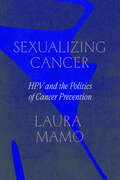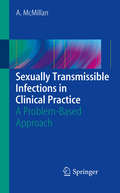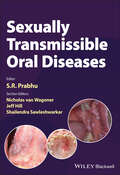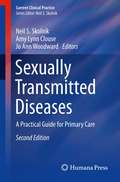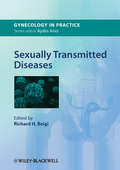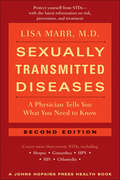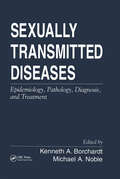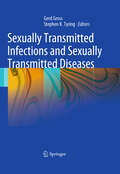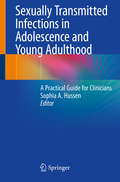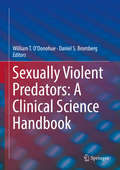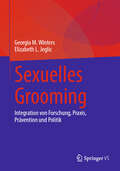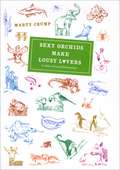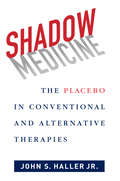- Table View
- List View
Sexualizing Cancer: HPV and the Politics of Cancer Prevention
by Laura MamoThe virus that changed how we think about cancer and its culprits—and the vaccine that changed how we talk about sex and its risks. Starting in 2005, people in the US and Europe were inundated with media coverage announcing the link between cervical cancer and the sexually transmitted virus HPV. Within a year, product ads promoted a vaccine targeting cancer’s viral cause, and girls and women became early consumers of this new cancer vaccine. An understanding of HPV’s broadening association with other cancers led to the identification of new at-risk populations—namely boys and men—and ignited a plethora of gender and sexual issues related to cancer prevention. Sexualizing Cancer is the first book dedicated to the emergence and proliferation of the HPV vaccine along with the medical capacity to screen for HPV—crucial landmarks in the cancer prevention arsenal based on a novel connection between sex and chronic disease. Interweaving accounts from the realms of biomedical science, public health, and social justice, Laura Mamo chronicles cervical cancer’s journey out of exam rooms and into public discourse. She shows how the late twentieth-century scientific breakthrough that identified the human papilloma virus as having a causative role in the onset of human cancer galvanized sexual politics, struggles for inclusion, new at-risk populations, and, ultimately, a new regime of cancer prevention. Mamo reveals how gender and other equity arguments from within scientific, medical, and advocate communities shaped vaccine guidelines, clinical trial funding, research practices, and clinical programs, with consequences that reverberate today. This is a must-read history of medical expansion—from a “woman’s disease” to a set of cancers that affect all genders—and of lingering sexualization, with specific gendered, racialized, and other contours along the way.
Sexualizing Cancer: HPV and the Politics of Cancer Prevention
by Laura MamoThe virus that changed how we think about cancer and its culprits—and the vaccine that changed how we talk about sex and its risks. Starting in 2005, people in the US and Europe were inundated with media coverage announcing the link between cervical cancer and the sexually transmitted virus HPV. Within a year, product ads promoted a vaccine targeting cancer’s viral cause, and girls and women became early consumers of this new cancer vaccine. An understanding of HPV’s broadening association with other cancers led to the identification of new at-risk populations—namely boys and men—and ignited a plethora of gender and sexual issues related to cancer prevention. Sexualizing Cancer is the first book dedicated to the emergence and proliferation of the HPV vaccine along with the medical capacity to screen for HPV—crucial landmarks in the cancer prevention arsenal based on a novel connection between sex and chronic disease. Interweaving accounts from the realms of biomedical science, public health, and social justice, Laura Mamo chronicles cervical cancer’s journey out of exam rooms and into public discourse. She shows how the late twentieth-century scientific breakthrough that identified the human papilloma virus as having a causative role in the onset of human cancer galvanized sexual politics, struggles for inclusion, new at-risk populations, and, ultimately, a new regime of cancer prevention. Mamo reveals how gender and other equity arguments from within scientific, medical, and advocate communities shaped vaccine guidelines, clinical trial funding, research practices, and clinical programs, with consequences that reverberate today. This is a must-read history of medical expansion—from a “woman’s disease” to a set of cancers that affect all genders—and of lingering sexualization, with specific gendered, racialized, and other contours along the way.
Sexually Transmissible Infections in Clinical Practice
by Alexander McmillanUndergraduate medical education has moved away from the former didactic style of teaching to one of problem-based learning. The specialty of Genitourinary Medicine (GUM) that includes sexually transmissible infections (STIs) lends itself to the latter; self-directed learning. This is particularly important as time allocated to the specialty in most medical curricula is short, and the student cannot possibly cover all the topics with which he/she is expected to be familiar. Several excellent textbooks on GUM exist, but they mostly follow the traditional format, with emphasis on individual diseases rather than case-scenarios. The books that follow a more syndromic approach do not pose questions to help the student understand how the material presented can be translated into clinical practice. As specialist clinics become more hard-pressed, family medicine practitioners are thus becoming increasingly involved in the management of STIs and there is without doubt now a need for a book specifically designed for problem solving in STI management.
Sexually Transmissible Oral Diseases
by Jeff Hill Nicholas Van Wagoner Shailendra SawleshwarkarSexually Transmissible Oral Diseases A Detailed Description of Sexually Transmissible Oral Diseases Relevant to Dental Practice Sexually Transmissible Oral Diseases delivers an expert and comprehensive description of sexually transmissible oral diseases encountered in clinical dental practice. This book features contributions from more than 20 international experts representing the disciplines of oral medicine, sexual health, infectious diseases, microbiology, community medicine, and dermatology. Divided into three relevant sections, readers will find: An overview of the etiology, epidemiology, and prevention of sexually transmitted infections, including HIV/AIDS. Details on risky sexual behaviors and their impact on oral health, including the risk of sexually transmissible diseases associated with oral sex. Detailed descriptions of oral manifestations of sexually transmissible infections. Diagnostic and treatment strategies for oral healthcare professionals in the dental setting. Clinical images that complement the user-friendly patient-focused approach of the book. Sexually Transmissible Oral Diseases is ideal for dental practitioners, oral medicine specialists, oral and maxillofacial surgeons, dental hygienists, oral health therapists, and dental educators. The book will also earn a place in medical and dental libraries as a recommended reference book for dental students, medical students, and students of other health professions.
Sexually Transmitted Diseases
by Neil S. Skolnik Amy Lynn Clouse Jo Ann WoodwardSexually Transmitted Diseases: A Guide for Primary Care, second edition, covers the diagnosis and treatment of STDs and other information critical to patient care and reflects the last five years of significant changes in information about STDs. Updated to reflect the 2010 Center for Disease Control Guidelines on the Treatment of STDs, this book also contains new information about: -the epidemiology of herpes virus infections -expedited partner therapy -changes in recommendations for HPV vaccination for men -changes in resistance patterns for antimicrobial therapy for gonorrhea and chlamydia -treatment recommendations for bacterial vaginosis -treatment recommendations for genital warts In order to better meet clinician needs, the book has been streamlined to quickly convey critical, evidence-based information. Whether seeking information about particular conditions (including HPV, herpes, syphilis, trichomoniasis, HIV and AIDS, and others) or related patient issues (such as STD exposure evaluation and evaluation of sexual assault), Sexually Transmitted Diseases, second edition, contains the knowledge doctors need in a friendly, to-the-point format.
Sexually Transmitted Diseases
by P. Frederick Sparling Rosanna PeelingA comprehensive collection of cutting-edge molecular protocols for the laboratory diagnosis and study of sexually transmitted diseases, including HIV. The methods-each crafted by a leading expert for comprehensiveness and genuine laboratory utility-cover the major sexually transmitted pathogens, including Neisseria gonorrhoeae, Chlamydia trachomatis, Haemophilius ducreyl, Treponema pallidum, and herpes simplex. Additional molecular techniques are included for detecting the genital mycoplasmas, hepatitis B virus, HIV-1, human papillomavirus. Sexually Transmitted Disease Protocols provides a comprehensive collection of foolproof molecular methods for STD diagnosis, research, and patient management.
Sexually Transmitted Diseases
by Richard H. BeigiSexually Transmitted Diseases present a major public health challenge. Over 25 diseases can be transmitted through sexual activity, and effective treatment, especially where long term infection can lead to further health problems, and in women infertility, requires good diagnostic skills and understanding of the best treatment methods. This book aims to give a practical guide to diagnosis and treamtent in a patient-centred framework, with care at the heart of the book.The aim of the Gynecology in Practice Series is to provide a clinical 'in the office' or 'at the bedside' guide to effective patient care for gynecologists. The tone will be practical, not academic. The working assumption is that readers want to know what (and what not) might or should be done, without over emphasis on the why. That said, it is important to review the crucial basic science necessary for effective diagnosis and management, and to provide reminders in the context of the practical chapters.The books will not be heavily referenced, in line with a more practical approach. This allows for smoother reading (and also relieves the burden of comprehensive citing from authors). Key evidence (clinical trials, Cochrane or other meta analyses) should be summarized in 'Evidence at a Glance' boxes and key references such as reviews, major papers can be provided in the 'selected bibliography' at the end of each chapter.Practical guidance will be provided through:the use of algorithms and guidelines where they are appropriate'Tips and Tricks' boxes - hints on improving outcomes perhaps via practical technique, patient questioning etc'Caution' warning boxes - hints on avoiding problems, perhaps via contraindications'Science Revisited' - quick reminder of the basic science principles necessary for understanding
Sexually Transmitted Diseases: A Physician Tells You What You Need to Know (A Johns Hopkins Press Health Book)
by Lisa MarrEvery year, millions of people are exposed to a sexually transmitted disease. And many people who are sexually active often worry about being infected. In her comprehensive guide to STDs, Dr. Lisa Marr tells readers everything they need to know about avoiding, preventing, and treating these diseases.Complete and up-to-date, this book describes safer sex practices, testing protocols, and symptoms, and details commonly known treatments as well as significant recent medical advances—including new testing for the herpes virus, the vaccine against the human papilloma virus (HPV), and new discoveries about the effectiveness of spermicides and condoms. For each disease, Dr. Marr offers the latest Sexually Transmitted Disease Treatment Guidelines from the Centers for Disease Control and Prevention.Forthright, compassionate, and practical, this guide is a trusted source of advice for anyone who is sexually active.
Sexually Transmitted Diseases: Epidemiology, Pathology, Diagnosis, and Treatment
by Kenneth A. Borchardt Michael A. NobleSexually transmitted diseases (STDs) are a worldwide problem affecting all nations and races. Such diseases are especially prevalent in developing countries where insufficient health care centers, inadequate laboratory capabilities, and the unavailablity of appropriate treatment perpetuate the problem. Sexually Transmitted Diseases: Epidemiology, Pathology, Diagnosis, and Treatment addresses the therapeutic challenges posed by STDs. It covers bacterial, spirochete, fungal, protozoan, viral, and ectoparasite infections. Strategies and progress in eliminating these diseases worldwide are discussed.
Sexually Transmitted Infections and Sexually Transmitted Diseases
by Gerd Gross Stephen K. TyringThis comprehensive, up-to-date reference book is intended to serve as the standard guide in the field. It covers the epidemiology and etiology of the various sexually transmitted infections and associated diseases, reviews novel diagnostic methods, and discusses in depth both new and established treatment methods. An important part of the book is devoted to prevention and particularly to immunoprevention by vaccination. Related issues such as sexual abuse, psychosocial aspects, and economic and political considerations are also included. The expertise of many worldwide renowned specialists and superb color illustrations make this book a valuable resource for practitioners from a variety of medical disciplines. It has a reader-friendly structure with "core messages" and "take-home pearls".
Sexually Transmitted Infections in Adolescence and Young Adulthood: A Practical Guide for Clinicians
by Sophia A. HussenThis book is designed to present a comprehensive and state-of the-art update that covers the pathophysiology, epidemiology, and clinical presentation of the most frequently encountered STIs in adolescence and young adulthood. The introductory sections discuss more general themes including approaches to obtaining a sexual history and exam, concerns of sexual minority youth, ethical and legal considerations, and health disparities in STIs in this population. Subsequent chapters are organized by pathogen such as herpes simplex virus, and human immunodeficiency virus, or clinical syndrome including pelvic inflammatory disease, and vaginitis. Each chapter begins with a case study to illustrate key characteristics of the disease process in question and includes rich illustrations, resources, and guidelines. Written by experts in the field, the text includes a review of epidemiology, pathophysiology, treatment, prevention, and adolescent-specific considerations that is vital to working with this important population. With its transdisciplinary perspective, Sexually Transmitted Infections in Adolescence and Young Adulthood is a unique text that is valuable to infectious disease specialists, adolescent medicine specialists, gynecologists, primary care physicians, advanced practice providers, medical administrative staff, school nurses, sexual health educators, social workers, and public health officials.
Sexually Transmitted Infections: Advances in Understanding and Management
by Antonio Cristaudo Massimo GiulianiThis comprehensive, well-illustrated, and easily accessible book documents the latest research outcomes concerning sexually transmitted infections (STIs) and describes important advances in their prevention, diagnosis and treatment. The changes in the epidemiology and clinical aspects of STIs that have occurred over the past decade are fully explored, with special attention to core groups and patients with immunological disorders. The emerging challenges associated with particular sexually transmitted pathogens, including C. trachomatis, N. gonorrhoeae, HPV, and HIV, are identified and discussed. Readers will find detailed information on modern preventive strategies, new laboratory and diagnostic techniques, and a range of innovative treatments, including vaccines, continuous antiretroviral therapy, and new drugs against hepatitis viruses. Attention is also drawn to new directions in biomedical research that promise clinical benefits for the patients and communities. The combination of a detailed clinical and research approach, with emphasis on new knowledge and innovative aspects, ensures that the book will be of value to a wide readership comprising both clinicians and researchers.
Sexually Violent Predators: A Clinical Science Handbook
by William T. O’Donohue Daniel S. BrombergThis information-rich volume expands current knowledge about sexually violent predators and critiques SVP laws with the goal of fostering improvements in clinical practice and public policy. It offers a finely detailed evidence base on this problematic class of offenders, including the complex interactions of biophysiological and environmental factors that contribute to criminal sexual behavior. Chapters discuss a wide range of assessment issues and instruments central to SVP evaluation, and the possibilities for developing interventions that address individual motivations and behaviors to reduce the risk of reoffending. And throughout, careful attention is paid to ongoing legal, ethical, and logical concerns regarding sexually violent offenders, their treatment and confinement, and their post-confinement placement. Among the topics covered:· Civil commitment of sex offenders.· The physiological basis of problematic sexual interests and behaviors.· Sexually violent predator evaluations: problems and proposals.· Cultural considerations in the assessment of sexually violent predators.· Management of sex offenders in community settings.· Effective use of an expert in sexually violent predator commitment hearings. Offering numerous issues for discussion and debate with considerable implications for clinical practice, policy, and the judicial system, Sexually Violent Predators will interest and enlighten forensic psychologists and psychiatrists as well as social workers, policy-makers, and legal professionals.
Sexualmedizin für die Praxis: Sexualberatung und Kurzinterventionen bei sexuellen Störungen
by Uwe Hartmann Tillmann Krüger Viola Kürbitz Christian NeuhofDas Buch vermittelt klinisch tätigen Ärzten verschiedener Fachbereiche das nötige Praxiswissen und die Fertigkeiten, die dazu befähigen:· Sexuelle Störungen zu erkennen und diagnostisch zu erfassen, inkl. der dazu notwendigen Gesprächsführungskompetenzen· Eine Sexualanamnese durchzuführen· Patienten mit sexuellen Störungen fachgerecht zu beraten· Patienten mit sexuellen Störungen unter systematischer Nutzung der Arzt-Patient-Beziehung und mit Fokus auf der Paardimension sexualmedizinisch zu behandeln und sexualtherapeutische Kurzinterventionen durchzuführen.Das Vorgehen der Gesprächsführung, Beratung und Behandlung beruht auf dem Hannover-Ansatz der Sexualtherapie. Er bietet einen allgemeinen, störungsübergreifenden Rahmen von beratenden und therapeutischen Fertigkeiten und Werkzeugen, die bei allen Patienten mit Sexualstörungen angewendet werden können. Darüber hinaus erhält der Leser die notwendigen spezifischen Kenntnisse über die verschiedenen Sexualstörungen inklusive der für diese verfügbaren aktuellen sexualmedizinischen und sexualtherapeutischen Behandlungsoptionen.Auch ärztliche und psychologische Psychotherapeuten sowie andere Berufsgruppen, die mit sexuellen Problemen konfrontierten Klienten arbeiten, finden in diesem Praxisleitfaden vieles für die tägliche Beratungspraxis. Das Buch deckt die Inhalte der Zusatzweiterbildung „Sexualmedizin“ der Bundesärztekammer sowie des Diploms „Sexualmedizin“ der Österreichischen Ärztekammer ab und vermittelt die dort festgelegten Kenntnisse und Fertigkeiten. Für die Prüfungsvorbereitung stehen dem Leser zahlreiche Flashcards zur Verfügung.
Sexualpädagogische (Re)Visionen: Sexualpädagogik als Diskriminierungsschutz für Schule und außerschulische Bildungsarbeit
by Annette VanagasIn dem Band werden sexualpädagogische Inhalte und deren Potenzial als Antidiskriminierungspädagogik verbunden. Thematisiert werden Homo- sowie Transfeindlichkeit, Geschlechterstereotype und deren Wirkung auf Körperlichkeit, Sexting und Bodyshaming. In ihren Beiträgen nähern sich die Autorinnen und Autoren aktuellen gesellschaftlichen Diskursen und ethischen wie moralischen Fragen und reflektieren deren pädagogische Implikationen.
Sexualstrafrecht in Medizin und Pflege: Grundlagen für die Pflegeausbildung (essentials)
by Ulf Haakon DammannDieses essential ist eine wertvolle Orientierungshilfe zum Thema Sexualstrafrecht f#65533;r Menschen in Pflegeberufen in der Aus-, Fort- und Weiterbildung. Ulf Haakon Dammann liefert eine kompakte #65533;bersicht #65533;ber Erkenntnismerkmale, Definitionen und Beispiele sowie Verhaltensweisen im Umgang mit Opfern (sexueller) Gewalt. Der Autor erl#65533;utert wesentliche Aspekte des Sexualstrafrechts in Deutschland und bereitet diese als Praxistipps f#65533;r Menschen in Pflegeberufen auf.
Sexuelle Freiheit aufgedeckt
by Thérèse Hargot Jakob Pastötter Lydia LundbeckWas haben wir aus der sexuellen Befreiung gemacht? Nach 50 Jahren sexueller Revolution ist so viel Sex im öffentlichen Raum wie seit der Antike nicht mehr. Doch wie beeinflusst dies die heutigen Jugendlichen? Dieses Buch deckt Auswirkungen und Zusammenhänge der sexuellen Befreiung auf. Basierend auf langjähriger Erfahrung in der schulischen Sexualaufklärung und gestützt durch viele anschauliche Beispiele schildert die Autorin minutiös und bisweilen erfrischend maliziös, was und wie Jugendliche und junge Erwachsene heute über Sexualität denken. Obwohl sich diese sexuell befreit fühlen, unterliegen sie doch vielfältigen Zwängen. Ohne ein Blatt vor den Mund zu nehmen vermittelt die Autorin anhand von vielen Beispielen, welche Auswirkungen Faktoren wie eine Bagatellisierung der Porno-Kultur, permanentes Leistungsstreben, hormonelle Verhütung und eine zwanghafte Suche nach sexueller Orientierung nach sich ziehen. Dabei wird deutlich, dass es ein Irrglaube ist, dass sich die Sexualität als Konsumgut instrumentalisieren und beherrschen, pädagogisch vermitteln, sozial konstruieren sowie pharmazeutisch und chirurgisch optimieren lässt. Das reale Liebesleben könnte sonst viel Leere, Frustration, Verunsicherung und Einsamkeit erfahren. Das Buch regt dazu an, das Wagnis einzugehen, sich den damit verbundenen Fragen des Lebens zu stellen und den Lernprozess der Sozialisierung im Bereich von Liebe, Sex und Beziehungen neu zu überdenken.
Sexuelles Grooming: Integration von Forschung, Praxis, Prävention und Politik
by Elizabeth L. Jeglic Georgia M. WintersDieses Buch bietet einen ausführlichen Überblick über den aktuellen Forschungsstand zum Thema Sexual Grooming. Es untersucht den Prozess, durch den eine Person, die eine sexuelle Straftat begehen will, ein potenzielles Opfer geschickt in Situationen manipuliert, in denen der Missbrauch leichter begangen werden kann, während gleichzeitig die Offenlegung und Entdeckung verhindert wird. Dieser Band befasst sich mit diesem wenig erforschten Phänomen und untersucht umfassend, was derzeit über dieses Konstrukt bekannt ist. Es bietet eine gründliche Einführung in die Literatur über sexuelles Grooming, wobei der Schwerpunkt auf der Geschichte des Begriffs liegt und darauf, wie sexuelle Grooming-Strategien durch öffentlichkeitswirksame Fälle und solche in Organisationen, die Kinder betreuen (z. B. katholische Kirche, Boy Scouts of America), öffentlich bekannt geworden sind. Das Buch gibt einen Überblick über die verschiedenen vorgeschlagenen Modelle des sexuellen Groomings - einschließlich des Sexual Grooming Model (SGM) -, in denen die übergreifenden Schritte oder Phasen des Prozesses beschrieben werden. Es diskutiert Versuche, das Konstrukt des sexuellen Groomings zu definieren, und befasst sich mit den möglichen Folgen des sexuellen Groomings, wobei der Schwerpunkt darauf liegt, wie Opfer, Familien und Gemeinden im Allgemeinen betroffen sein können. Zu den wichtigsten Themenbereichen gehören: Einzigartige Kontexte und Facetten, in denen sexuelles Grooming-Verhalten beobachtet wurde, einschließlich Online-Grooming, persönliches/Self-Grooming, familiäres Grooming, institutionelles Grooming und Grooming-Verhalten von weiblichen Personen. Die Art und Weise, in der sich sexuelle Grooming-Strategien in Fällen von Sexhandel und sexuellem Missbrauch von Erwachsenen manifestieren können. Bewertung und Behandlung von sexuellem Grooming sowie Präventionsstrategien. Durchführung von Grooming-Forschungen als Grundlage für Strafverfolgungsmaßnahmen und gerichtliche Entscheidungen. Die Ausarbeitung und Verabschiedung von Gesetzen und Strategien zur Verhinderung von sexuellem Grooming. Child Sexual Grooming ist ein unverzichtbares Hilfsmittel für Forscher, Professoren, Studenten, Kliniker, Psychotherapeuten, Juristen, politische Entscheidungsträger, Strafverfolgungsbehörden und verwandte Berufsgruppen in den Bereichen Entwicklungspsychologie, Kinder- und Jugendpsychologie, Sozialarbeit, öffentliches Gesundheitswesen, Kriminologie/Strafjustiz, forensische Psychologie sowie Verhaltenstherapie und Rehabilitation.
Sexy Orchids Make Lousy Lovers & Other Unusual Relationships
by Marty CrumpThis book captures the bizarre and befuddling aspects of the behavior of animals, plants, and microbes.
Señoras: Una guía integral de la salud en la menopausia
by Elena Del Estal Perez Alberta Maria Fabris Adriana Fernandez Caamaño Tania Rodriguez Manglano«Un libro eminentemente práctico y útil para transitar con elegancia por la temida menopausia». —Anna Freixas, autora bestseller de Nuestra menopausia¿Qué hacer con los sofocos? ¿Es normal que vuelva la regla después de tanto tiempo (¡y justo el día que usas pantalones blancos!)? ¿Se puede prevenir la osteoporosis? ¿Adónde se fue el deseo?Para muchas mujeres, la menopausia es un terreno incierto, más cercano a una enfermedad o una tortura que una etapa vital digna de ser disfrutada. Sin embargo, cuando disponemos de las herramientas y la orientación adecuadas, es posible transformar radicalmente esta experiencia.Señoras es una guía práctica y compasiva, escrita por cuatro profesionales de la salud con una perspectiva feminista, donde encontrarás todo lo que necesitas saber y escuchar sobre la menopausia y el climaterio. Desde explicaciones científicas y rutinas de ejercicios ilustradas, hasta reflexiones en torno a los prejuicios médicos y sociales que invisibilizan los «asuntos de mujeres».Sin importar si ya estás transitando o no este camino, estas páginas serán tus mejores aliadas para vivir una madurez plena, libre de miedos y prejuicios. Como una verdadera señora. -----A comprehensive guide to celebrate and embrace maturity without fear or prejudice. What to do about hot flashes? Is it normal for your period to come back after so long (and on the day you’re wearing white pants, no less!)? Can osteoporosis be prevented? Where did your sex drive go?For many women, menopause is an uncertain terrain, more like an illness or torture than a vital stage worth enjoying. However, with the right tools and guidance, this experience can be radically transformed.Señoras is a practical and compassionate guide, written by four health professionals from a feminist perspective, where you’ll find everything you need to know and hear about menopause and the climacteric. From scientific explanations and illustrated exercise routines to reflections on the medical and social biases that render “women’s issues” invisible.Whether or not you’re already on this journey, these pages will be your best allies in living a full maturity, free from fear and prejudice. Like a true señora.
Sh!thouse: A Memoir
by Lauren Dollie DukeSh!thouse: A Memoir is a story of brutal girlhood. Lauren was seven when she helped her step-father boost rum bottles from the local liquor store. The next year, her biological father took her to a hotel room and shot up heroin in the bathroom. The next day he robbed a bank with a finger gun! When he was released from prison, he moved into Lauren’s basement. They spent the weekends smoking cartons of cigarettes, diving into dumpsters and swindling used cars. Lauren’s upbringing provided her with only one lens through which she saw herself – shame. And that shame overflowed into every aspect of her life. In this compassionate and gritty real-life fairytale the author, Lauren Dollie Duke, shows how it’s possible for good people to do bad things and what it takes to create peace with where you come from in order to find true happiness. This raw and humorous account about trauma, transcendence and resilience challenges the binary of good vs. evil. It lays out the evolution of shame psychology and intergenerational trauma seeking to answer the question of how we unravel ourselves from the history and patterns of our families. Sh!thouse will make you want to investigate your own historical patterns, examine all of your relationships, and forgive everyone, including yourself. It’s a tether to our shared humanity which reminds us there is belonging in the world no matter how horrific it was to start. It is a beautifully written map that draws back to the personal root of where sabotaging behavior, shame and limitation is born.
Shadow Medicine: The Placebo in Conventional and Alternative Therapies
by Jr. John HallerCan Evidence Based Medicine (EBM) and Complementary and Alternative Medicine (CAM) find common ground? A distinguished historian of medicine, John S. Haller Jr., explores the epistemological foundations of EBM and the challenges these conceptual tools present for both conventional and alternative therapies. As he explores a possible reconciliation between their conflicting approaches, Haller maintains a healthy, scientific skepticism yet finds promise in select complementary and alternative (CAM) therapies. Haller elucidates recent research on the placebo effect and shows how a new engagement between EBM and CAM might lead to a more productive medical practice that includes both the objectivity of evidence-based medicine and the subjective truth of the physician-patient relationship. Haller's book tours key topics in the standoff between EBM and CAM: how and why the double blinded, randomized clinical trial (RCT) came to be considered the gold standard in modern medicine; the challenge of postmodern medicine as it counters the positivism of evidence-based medicine; and the politics of modern CAM and the rise of the National Center for Complementary and Alternative Medicine. He conducts an in-depth case study of homeopathy, explaining why it has emerged as a poster-child for CAM, and assesses CAM's popularity despite its poor performance in clinical trials. Haller concludes with hope, showing how new experimental protocols might tease out the evidentiary basis for the placebo effect and establish a foundation for some reconciliation between EBM and CAM.
Shadow of a Doubt: The twisty psychological thriller inspired by a real life story that will keep you reading long into the night
by Michelle Davies'Pure suspense, where past and present collide with chilling results' Erin Kelly'A hugely entertaining, fast-paced thriller' Caz Frear'It's a pitch-perfect blend of ghostly terror and pacey thriller' Catherine Ryan Howard'Dark, spooky and brilliantly plotted, the perfect read for dark winter nights' Harriet TyceTwenty-six years ago my brother was murdered in my family home.I was sent to a psychiatric unit for killing him.The truth is, I didn't do it.The whole world believed eight-year-old Cara killed her younger brother on that fateful night. But she blamed it on a paranormal entity she swears was haunting her house.No one believed her and after two years of treatment in a psychiatric unit for delusional disorder, Cara was shunned by her remaining family and put into foster care.Now she's being forced to return to the family home for the first time since her brother's death, but what if she's about to re-discover the evil that was lurking inside its walls?
Shadow of the Mountains (Cheney Duval, MD #2)
by Lynn MorrisCHENEY DUVALL has proved herself a true doctor to those two hundred brides with whom she traveled to the West by sea. But a string of medical successes during the voyage does not open any doors for her upon her arrival in Seattle. In this frontier town, she's "jest a woman." Dejected, she returns home to Philadelphia. When she receives a letter with an invitation to a remote spot in the Ozark Mountains where there are no doctors at all, Cheney feels compelled to go. But the local people are less than welcoming. Cheney runs into walls of illiteracy, superstition, and immovable distrust of Yankees--especially an "edjicated female [who] thinks she's a real doc." How will she overcome centuries of hate and mistrust?
Shadows Bright as Glass
by Amy E NuttOn a sunny fall afternoon in 1988, Jon Sarkin was playing golf when, without a whisper of warning, his life changed forever. As he bent down to pick up his golf ball, something strange and massive happened inside his head; part of his brain seemed to unhinge, to split apart and float away. For an utterly inexplicable reason, a tiny blood vessel, thin as a thread, deep inside the folds of his gray matter had suddenly shifted ever so slightly, rubbing up against his acoustic nerve. Any noise now caused him excruciating pain. After months of seeking treatment to no avail, in desperation Sarkin resorted to radical deep-brain surgery, which seemed to go well until during recovery his brain began to bleed and he suffered a major stroke. When he awoke, he was a different man. Before the stroke, he was a calm, disciplined chiropractor, a happily married husband and father of a newborn son. Now he was transformed into a volatile and wildly exuberant obsessive, seized by a manic desire to create art, devoting virtually all his waking hours to furiously drawing, painting, and writing poems and letters to himself, strangely detached from his wife and child, and unable to return to his normal working life. His sense of self had been shattered, his intellect intact but his way of being drastically altered. His art became a relentless quest for the right words and pictures to unlock the secrets of how to live this strange new life. And what was even stranger was that he remembered his former self. In a beautifully crafted narrative, award-winning journalist and Pulitzer Prize finalist Amy Ellis Nutt interweaves Sarkin's remarkable story with a fascinating tour of the history of and latest findings in neuroscience and evolution that illuminate how the brain produces, from its web of billions of neurons and chaos of liquid electrical pulses, the richness of human experience that makes us who we are. Nutt brings vividly to life pivotal moments of discovery in neuroscience, from the shocking "rebirth" of a young girl hanged in 1650 to the first autopsy of an autistic savant's brain, and the extraordinary true stories of people whose personalities and cognitive abilities were dramatically altered by brain trauma, often in shocking ways. Probing recent revelations about the workings of creativity in the brain and the role of art in the evolution of human intelligence, she reveals how Jon Sarkin's obsessive need to create mirrors the earliest function of art in the brain. Introducing major findings about how our sense of self transcends the bounds of our own bodies, she explores how it is that the brain generates an individual "self" and how, if damage to our brains can so alter who we are, we can nonetheless be said to have a soul. For Jon Sarkin, with his personality and sense of self permanently altered, making art became his bridge back to life, a means of reassembling from the shards of his former self a new man who could rejoin his family and fashion a viable life. He is now an acclaimed artist who exhibits at some of the country's most prestigious venues, as well as a devoted husband to his wife, Kim, and father to their three children. At once wrenching and inspiring, this is a story of the remarkable human capacity to overcome the most daunting obstacles and of the extraordinary workings of the human mind.
